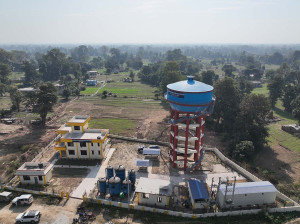Money
Cross-border power line project stalls due to slow paperwork
Nepal and India agreed to execute the 400 kV New Butwal-Gorakhpur Transmission Line Project nearly two months ago..jpg&w=900&height=601)
Prahlad Rijal
Nepal and India agreed to execute the New Butwal-Gorakhpur Transmission Line Project nearly two months ago, but authorities are yet to begin the required paperwork for timely initiation of the much-touted scheme.
The 400 kV cross-border power line project is being implemented under a company model with equal equity investment. In October, a secretary-level meeting between the two countries had decided to form a joint venture between the Nepal Electricity Authority and Power Grid Corporation of India within three months, and conclude an Implementation and Transmission Service Agreement to build the Indian portion of the line within six months.
Around 120 kilometres of the 135-kilometre-long transmission line lies in Indian territory.
“As the process of forming a company under a bilateral mechanism takes time, they should have begun the necessary homework by now,” said Gokarna Raj Panta, deputy spokesperson for the Ministry of Energy, Water Resources and Irrigation. “Even if some work is being carried out, nothing has materialised yet.”
The two sides finally agreed on the implementation and funding modality of the project, which is expected to cost around Rs13 billion, after multiple discussions.
An agreement to build the cross-border line through a commercial entity was forged after India rejected Nepal's initial proposal to implement the project under a government-to-government financial model.
As per the agreement, the project would be implemented with 80 percent debt financing and 20 percent equity investment by the Nepal Electricity Authority and Power Grid Corporation of India.
According to an official close to the situation, a debt arrangement can only be performed after the formation of the joint venture, and delays in its formation will push back the project completion deadline set for 2022.
“Nepal urgently needs to develop high capacity transmission lines to synchronise the power grid with India to allow smooth export of surplus energy which will appear in a year,” said the official. “Developing a high capacity line and evacuating electricity through it will significantly reduce the cost of transmission.”
Energy officials plan to fund the Nepali portion of the transmission line through funds obtained from the Electricity Transmission Project under the multi-million dollar Nepal Compact signed with Millennium Challenge Corporation of the US.
An agreement between officials of the two neighbouring countries on implementing the transmission line was also a pre-requisite for the multi-million dollar MCC-Nepal compact — viewed by many in Nepal as a counter-initiative under the Indo-Pacific Strategy of the US against China's Belt and Road Initiative — which was achieved in October.
The Compact, which will prevail over domestic laws, is awaiting ratification by Parliament. It has been held up for nearly a year due to differences between ruling party lawmakers and leaders over the degree of Nepal’s involvement in the Indo-Pacific Strategy and the Belt and Road Initiative.
Millennium Challenge Account-Nepal, the project's implementing agency, has laid plans to initiate the projects under the Compact by June 2020, and is currently holding talks with potential contractors on the design, supply and commissioning of around 300 kilometres of the transmission line in its basket.
Indian authorities have also revised the detailed project report of the cross-border transmission system leading to a cost reduction of around $18 million on the Indian portion.
According to the Nepal Electricity Authority, the country will witness a surplus of around 1,000 megawatts of electricity in the next fiscal year when a slew of plants are slated to come online, surpassing slow growing domestic demand for electricity.
In view of the projection and market requirements, studies have suggested timely completion of the New Butwal-Gorakhpur Transmission Line Project outlining Butwal as the evacuation point and a strategic location because of its proximity with India’s Uttar Pradesh state and the Northern Regional Load Dispatch Centre via Gorakhpur where power demand is high during the monsoon.
The transmission line is being built to evacuate power from the Marsyangdi and Kali Gandaki corridors which have a high concentration of hydel schemes.




 19.12°C Kathmandu
19.12°C Kathmandu















